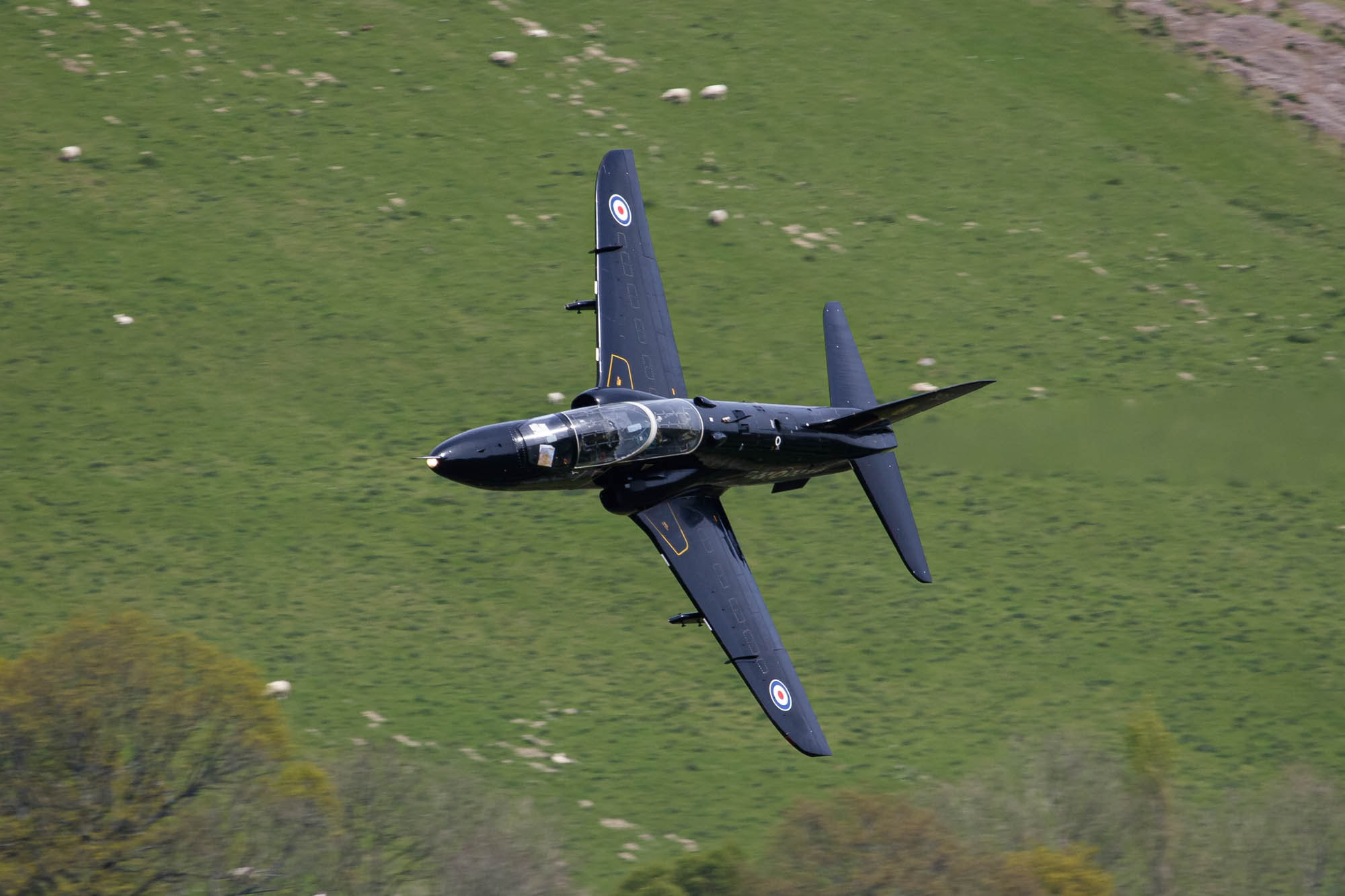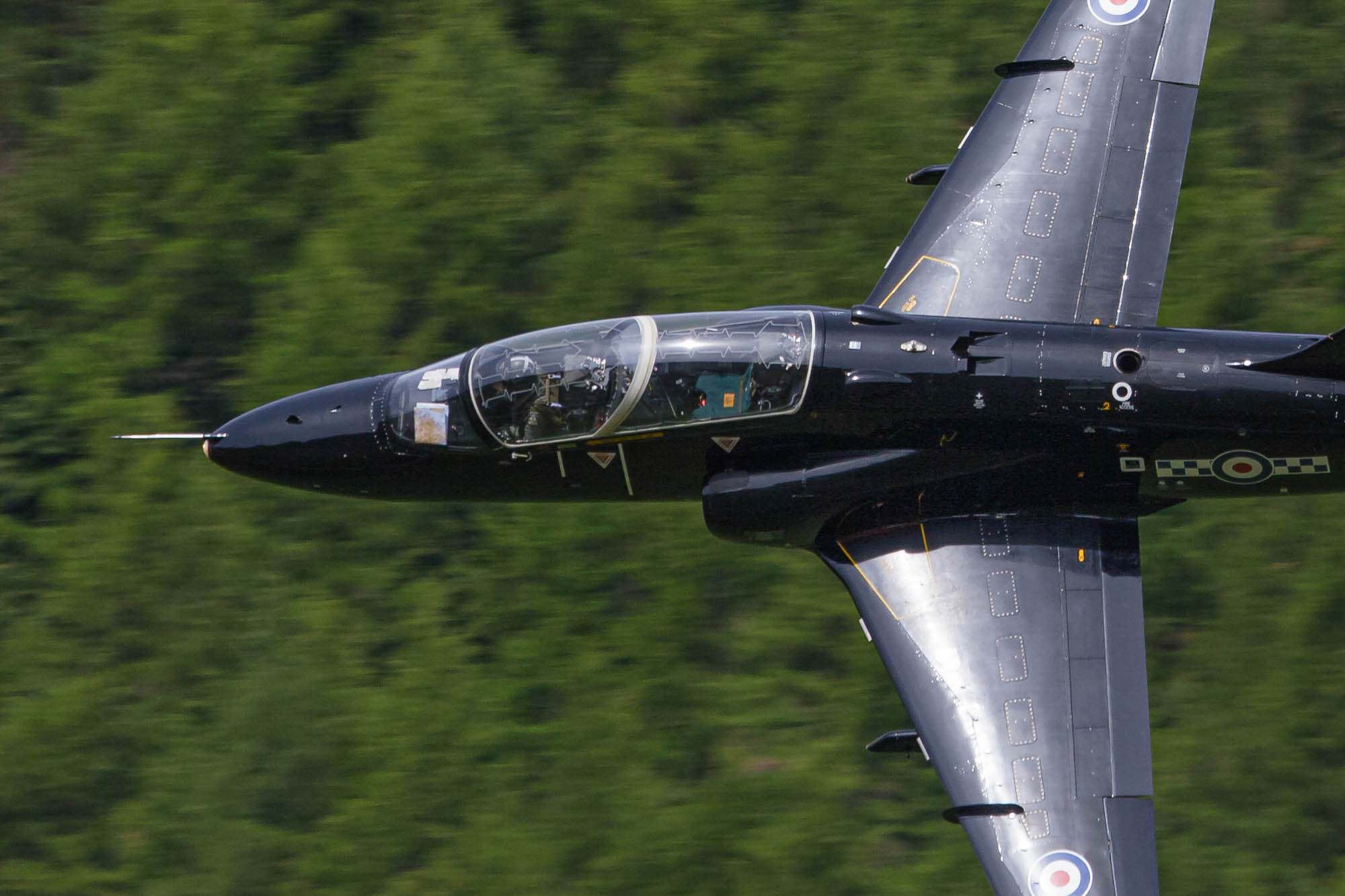Low-Level Flying Photography
Prince of Wales Trophy
May 11, 2005
|
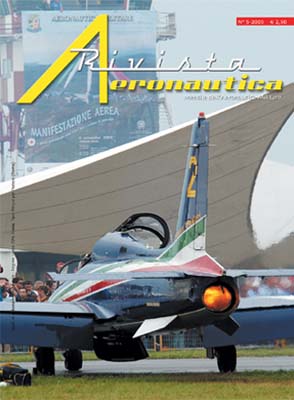
RAF Valley in Anglesey, North Wales, is the home of 4 Flying Training Squadron (4 FTS) also known as the fast-jet ATTU (Advanced Training and Tactics Unit). At Valley there are two flying training roles; that of advanced flying training with 208 Squadron and tactical weapons training with 19 (Reserve) Squadron.
Three types of instructors are trained at Valley and they pass on their skills to up to 100 students each year. The staff instructors consist of; Qualified Flying Instructors (QFI), Qualified Tactical Instructors (QTI) and Qualified Weapons Instructors (QWI).
Every year, RAF Valley organises a low-level navigational competition, known as the Prince of Wales Trophy, for its staff instructors from both 19(R) and 208 Squadrons. In recent years it has been held every October, however due to poor weather last year, the exercise was postponed to May 11, 2005. Flying alone in the two-seat BAE Systems Hawk T.1/1A advanced jet trainer, the pilot has to find his way to seven or eight targets or events. These are found somewhere in low-flying area 7 (LFA 7), which covers most of Wales. Some events are timed, the pilots being awarded 100 points if they pass through a time gate to the second. Manpower is used on the ground to monitor these. Pilots are penalised for every second out. To avoid any chance of a draw (which has happened), the points are now divided down to tenths. Using a logarithmic scale, you could be awarded just one tenth of a point if either 50 seconds early or late. Part of the approximately 50 minute sortie, is reconnaissance, where a predetermined feature on the ground has to be identified, typically this could be a gate or a barn. In previous years life-rafts, Land Rovers and even inflatable tanks, have been used. Only one pass is allowed over any of the targets to be identified. Pilots are obliged to comply with the rules for low-flying and the rules for the competition. They are cleared down to a height of 250 feet Above Ground Level (AGL), which is the height stated for attacking the targets. Guidance is not given for the route and flight levels to be flown between the targets, however. The strict time constraints do influence the routing and levels taken by aircrew. Each aircraft is flown 'clean' as no weapons are used in the competition. |
The exercise is open to all staff instructors, however of the 50 or 60 instructors that take part, the winner is likely to be from 19(R) Squadron, as the tasks involved in the competition are typical of their daily training. Impressively last year's winner was just seven seconds away from a perfect time.
Rapid planning is an essential part of the exercise, the pilots are given an envelope containing the 'Air Task Message' (ATM) with details of the designated tasks and target positions. They receive the ATM just 1½ hours before their take-off slot, in which time they will choose their route. The only feature laid down on the map is a deconfliction line, which should not be crossed. This line separates the north-south from south-north aircraft as they travel around the LFA. Pilots will also decide upon an Initial Point (IP), for their run on each target. An IP is a position some miles short of the target. The concept of the IP is to ensure that pilots approach their target from a known position and on a known track. Having passed over the IP they then fly along a designated track to the target.
For the timed events, speed and distance needs to be carefully considered. Typically the aircraft are flown at 420 knots or seven nautical miles a minute, which makes timing calculations simple. If they flew in a straight line from point to point it would cause them to arrive early. The reason for this is to ensure each pilot slightly varies his or her route, to make sure low-flying aircraft throughout the day are not constantly disturbing people on the ground. Squadron Leader Mark Byrne, Corporate Communication Officer at RAF Valley as last year's competition organiser, is particularly pleased that complaints from the public as a result of this event are almost unheard of these days. Incidentally Sqn Ldr Byrne, was project officer for last year's broadcast on BBC, entitled 'Combat Pilot'. Over 1.1 million viewers enjoyed the program every week, which followed student pilots through their training course at RAF Valley. For his efforts, Wing Commander Phil Greville, Officer Commanding Operations Wing, presented him with the RAF Award for Excellence 2004, at RAF Valley.
Is this just a bit of fun?
After hearing about the event, I posed the question; "Is this competition just a bit of fun for the flying instructors at Valley, to show off their skills in front of their students?" As expected, I was informed that this was not the case. The Squadron Leader continued, "Whilst the competition is not part of the annual training requirement, it is very useful for the flying instructors as they are in the back seat all year. The competition enables them to hone or sharpen up their skills regarding rapid planning, precision targeting and low-flying." He went on further to say, "Competition is good."
The 'course' if we can call it that, is usually around 280 to 350 nautical miles in length and is different each year. It is a strictly kept secret, known to just a handful of the organisers, until the actual day of the exercise. As some valleys are part of one way systems or 'flowed', I was told that these rules are not relaxed even though on the day the LFA is closed to all other aircraft.
Pilots of fast jets are able to cope well with high pressure. Here though, the instructors are demonstrating their skills in front of their students, who grounded for the day, monitor the scores closely. Adding to the pressure, as a side event, competing pilots are 'auctioned' for charity, which raised a very creditable £3000 last time in October 2003. At a function in the Officers Mess prior to this year's competition, the pilot auction raised a further £600 for charity.
This years Trophy Competition
Held on May 11, this trophy was contested over a course flown roughly clockwise around LFA 7 and a departure from recent years, which have been in a anti-clockwise direction. Sqn Ldr Byrne did a reconnaissance of the area a few weeks earlier. The targets have to be selected and proven, their viability was checked with a Hawk in the preceding days. Eight targets were selected for this years competition.
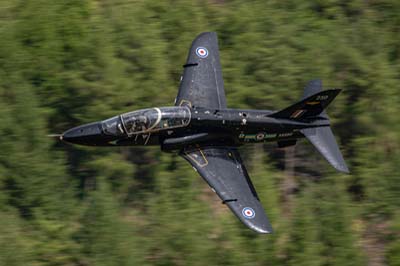 From 07:30 the 'Weather Hawk' flew to each target area, to make sure local weather conditions were acceptable. I was in position at my chosen location and conditions appeared perfect, very little cloud and excellent visibility. The first of 58 Hawks released brakes at exactly 10:03, continuing in five-minute intervals throughout the day. I asked why they started at 10:03. "We use minutes three and eight because there is a possibility of mis-reading the time by a minute, it would be very easy if we used five past, ten past etc." I was told. The first mark of the day depended on brake release on the runway which is timed to the second. The first airborne event was a timed entrance gate at Puffin Island which they flew at 1000 feet. The third event was a timed survivor reconnaissance, which was set up at the end of a small lake in Clocaenog Forest. Here a ground to air signal is used, which the pilots had to find at an exact time and give a post mission report. They had to be accurate, as the signal would only have been visible for a few seconds. The fourth event was another timed snap reconnaissance, this time two Service Land Rovers which were parked in a lay-by and were only visible briefly, as they passed over or around some high ground in mid Wales. Again they had to give an accurate description on their post mission report to receive all their timing marks. Next, was a simple timed over-fly of a small quarry entrance in the Lampeter area. However, if they did not fly exactly over the centre of the quarry entrance, they were penalised a proportion of their timing marks on a sliding scale depending on how far out they were. Still on track and time hopefully, they now had to attack a small bridge at an exact time, while accurately flying over the bridge.
From 07:30 the 'Weather Hawk' flew to each target area, to make sure local weather conditions were acceptable. I was in position at my chosen location and conditions appeared perfect, very little cloud and excellent visibility. The first of 58 Hawks released brakes at exactly 10:03, continuing in five-minute intervals throughout the day. I asked why they started at 10:03. "We use minutes three and eight because there is a possibility of mis-reading the time by a minute, it would be very easy if we used five past, ten past etc." I was told. The first mark of the day depended on brake release on the runway which is timed to the second. The first airborne event was a timed entrance gate at Puffin Island which they flew at 1000 feet. The third event was a timed survivor reconnaissance, which was set up at the end of a small lake in Clocaenog Forest. Here a ground to air signal is used, which the pilots had to find at an exact time and give a post mission report. They had to be accurate, as the signal would only have been visible for a few seconds. The fourth event was another timed snap reconnaissance, this time two Service Land Rovers which were parked in a lay-by and were only visible briefly, as they passed over or around some high ground in mid Wales. Again they had to give an accurate description on their post mission report to receive all their timing marks. Next, was a simple timed over-fly of a small quarry entrance in the Lampeter area. However, if they did not fly exactly over the centre of the quarry entrance, they were penalised a proportion of their timing marks on a sliding scale depending on how far out they were. Still on track and time hopefully, they now had to attack a small bridge at an exact time, while accurately flying over the bridge.
In the past some of the competitions have been very close, just seconds separating the very best on the day. Clearly this years competition needed to be challenging and the seventh event was designed to catch the pilots out, I was told. Pilots were given the task of accurately over-flying a bridge on their target time in the vicinity of Lake Celyn. The co-ordinates supplied, a twelve-figure grid reference, placed the bridge about 120 meters to the north of a small B road. Unfortunately for the competitors, there is a rather large and imposing stone bridge on the B road that spans a stream and is highly visible from the air, this was not the target. The target was a small and insignificant stone bridge that is only used by the many sheep in the area. The path across it is covered by grass, making it very difficult to see, especially once you have already picked out the larger bridge. Only eight competitors accurately over-flew the correct bridge with another eight being slightly off, some of whom obviously picked up the target bridge at a late stage. It is no surprise that the winner of the competition was one of the pilots who correctly over-flew the correct bridge.
The eighth and final event was a recovery to Valley along a specified radial from the Valley TACAN, wearing a correct IFF squawk. The event was scored on the time they passed overhead the Control Tower but they were only given their event time once they had established two-way contact with Valley ATC on recovery. On this event, the pilots would lose all of their timing marks if they were wearing the incorrect IFF squawk or if they approached along an incorrect recovery lane. Only six pilots failed to follow the correct approach criteria.
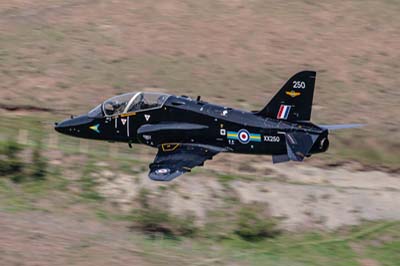 On the day, I wanted to get above the action for some low-level action photography. Positioned south of target six in mid-Wales I was told that the first Hawk would appear at 10:32. I should also expect the last Hawk through at around 16:20. Photography in the valleys was very difficult on the day. The instructors normally fly at about 1000 to 2000 feet AGL between targets. A pilot clarified this by saying, "flying at this height means we can focus on sorting out maps and checking our timings, without the fear of hitting the ground. "In addition it gives a little more flexibility with timings. Overall it is for reasons of safety, by concentrating more on the target and not having to worry about terrain." Whilst many of the instructors flew above my elevated location, a number still chose to lose a little time by flying low through my particular valley. I saw one pilot make a 360 degree tight orbit to waste a little time, before continuing on to the next target. I noticed that at least one of the Hawks had been around less than three hours earlier.
On the day, I wanted to get above the action for some low-level action photography. Positioned south of target six in mid-Wales I was told that the first Hawk would appear at 10:32. I should also expect the last Hawk through at around 16:20. Photography in the valleys was very difficult on the day. The instructors normally fly at about 1000 to 2000 feet AGL between targets. A pilot clarified this by saying, "flying at this height means we can focus on sorting out maps and checking our timings, without the fear of hitting the ground. "In addition it gives a little more flexibility with timings. Overall it is for reasons of safety, by concentrating more on the target and not having to worry about terrain." Whilst many of the instructors flew above my elevated location, a number still chose to lose a little time by flying low through my particular valley. I saw one pilot make a 360 degree tight orbit to waste a little time, before continuing on to the next target. I noticed that at least one of the Hawks had been around less than three hours earlier.
So with a possible overall score of 800 points, (eight events each worth 100 points) how did they perform? The winning pilot achieved a score of 720.7 points, with the second place pilot scoring 692.5 points and third place scoring 689.2 points. Unsurprisingly the winner was from 19(R) Squadron. "This stuff is their bread and butter", I was told. Nevertheless to their credit 208 Squadron achieved second place and a commendable proportion of top ten places. HRH Prince Charles who is RAF Valley's Honorary Commodore, presented the Prince of Wales' Trophy to the last two winners (2003 and 2005) on May 23.
History of the Trophy
The Prince of Wales Trophy was started in the 1980s by 1 TWU at RAF Brawdy, it was then a navigational and bombing (Pembrey Range) competition. Also in those early days the 1 TWU Hawks were often joined by Tornado GR.1s and Jaguar GR.1s. After the closure of Brawdy and a break in the 90s, the competition was restarted five years ago. These days the competition is only open to 4 FTS and its Hawks.
The Future of the Competition
Scheduled from now on for May, 2006 saw the event revert back to a bombing competition. The 4 FTS Hawks will now fly down to the range at Pembrey at medium level to preserve fuel, low-level movements on the day in Wales will be minimal. |
BAE Systems Hawk T.1
The BAE Systems Hawk T.1/1A is a very agile aircraft, popular amongst the pilots that have flown it over the previous 30 years. A single Rolls-Royce Turbomeca Adour turbofan engine, which produces 5,200 lbs of thrust, powers the Hawk T.1/1A, enabling the Hawk to attain a maximum speed of 633 mph (1,013 Km/h). The Red Arrows display team has used the Hawk, for the past 25 years.
The Hawk T.1 is solely used for advanced flying training. The T.1A is equipped to an operational standard and has two under-wing pylons cleared to carry BL755 cluster bombs or Sidewinder AIM-9L air to air missiles. It can also carry a 30mm Aden canon in a pod fitted underneath the fuselage centre-line. Aiming for the T.1A's attack modes are provided by an integrated strike and interception system, a Vinten video recording system records weapon sighting. |
